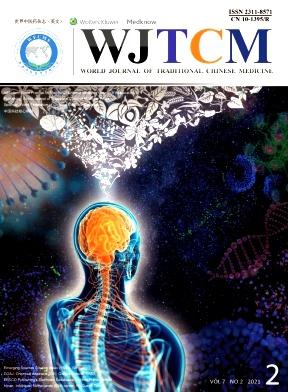Mechanism of wuweijiangyasan in the treatment of spontaneous hypertension based on network pharmacology
IF 3.2
3区 医学
Q1 INTEGRATIVE & COMPLEMENTARY MEDICINE
引用次数: 0
Abstract
Background: Hypertension affects over 1 billion people globally and is the top risk factor of cardiovascular morbidity and mortality. Wuweijiangyasan (WWJYS), as an empirical prescription, has stable depressurization effects. This study investigated the chemical composition and pharmacodynamic effects of WWJYS in regulating the blood pressure (BP), emotion, and blood lipid of spontaneous hypertensive rats, and further explored the depressurization mechanism of WWJYS. Materials and Methods: This study used network pharmacology to identify the origins and predict targets of WWJYS, and artificial intelligence-based molecular docking is used to further predict targets and mechanisms. The chemical constituents of WWJYS were analyzed and identified by ultra high-performance liquid chromatography–mass spectrometry (MS)/MS. Results: In the WWJYS group, the systolic BP level significantly was decreased, and the HR was stable. The irritability became stable after the 5-week treatment compared with the model group (P < 0.05). Rats' rotation tolerance time increased after 2-weeks stabilization. Compared with the model group, angiotensin-converting enzyme 2 protein and mRNA of the WWJYS group increased significantly (P < 0.05). Network pharmacology collected 64 compounds and identified 22 potential targets of WWJYS for antihypertensive activity. Gene Ontology and Kyoto Encyclopedia of Genes and Genomes enrichment analysis showed that WWJYS might regulate smooth muscle cells, affect inflammatory response and improve endothelial function through multiple pathways. The molecular docking study further supported that the target proteins have good combinations with the main active components of WWJYS. Conclusions: The data indicated that WWJYS had significant depressurization, analgesic, and sedative, as well as lipid-lowering effects, and the depressurization mechanism of WWJYS may function in multiple signal pathways, especially in improving blood vessel function and intervening inflammation.基于网络药理学的五味降压散治疗自发性高血压的作用机制
背景:高血压影响着全球超过10亿人,是心血管疾病发病率和死亡率的最高风险因素。五味降压散(WWJYS)作为一种经验方,具有稳定的降压效果。本研究考察了WWJYS的化学成分及其对自发性高血压大鼠血压、情绪和血脂的调节作用,并进一步探讨了WWJYS的降压机制。材料与方法:本研究采用网络药理学方法确定WWJYS的起源和预测靶标,并采用基于人工智能的分子对接方法进一步预测靶标和机制。采用超高效液相色谱-质谱(MS)/MS对WWJYS的化学成分进行了分析鉴定。结果:WWJYS组收缩压明显下降,HR稳定。治疗5周后应激反应较模型组稳定(P<0.05),2周后大鼠旋转耐受时间增加。与模型组相比,WWJYS组的血管紧张素转换酶2蛋白和mRNA显著增加(P<0.05)。网络药理学收集了64个化合物,鉴定了22个WWJYS降压活性的潜在靶点。Gene Ontology和Kyoto Encyclopedia of Genes and Genomes富集分析表明,WWJYS可能通过多种途径调节平滑肌细胞、影响炎症反应和改善内皮功能。分子对接研究进一步支持了靶蛋白与WWJYS的主要活性成分具有良好的组合。结论:WWJYS具有显著的降压、镇痛、镇静和降脂作用,其降压机制可能通过多种信号通路发挥作用,尤其是在改善血管功能和干预炎症方面。
本文章由计算机程序翻译,如有差异,请以英文原文为准。
求助全文
约1分钟内获得全文
求助全文
来源期刊

World Journal of Traditional Chinese Medicine
Medicine-Complementary and Alternative Medicine
CiteScore
5.40
自引率
2.30%
发文量
259
审稿时长
24 weeks
 求助内容:
求助内容: 应助结果提醒方式:
应助结果提醒方式:


